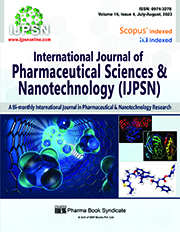Phytochemical Screening, Analgesic and Anti-Inflammatory Activity of the Ethanol Extract of the Cnidoscolus Phyllacanthus Leaves
Analgesic and Anti-Inflammatory Activity Cnidoscolus phyllacanthus Leaves
DOI:
https://doi.org/10.37285/ijpsn.2023.16.4.5Abstract
Objective: The present study aimed to investigate the analgesic and anti-inflammatory activity of the Cnidoscolus phyllacanthus (family Euphorbiaceae) ethanolic leaves extract in the laboratory using in vivo methods to justify its traditional use in the above-mentioned pathological conditions.
Methods: Phytochemical screening was done to find the presence of various secondary metabolites of the plant. In vivo, analgesic activity was performed employing the acetic acid-induced writhing test and tail immersion test on Swiss albino mice at doses of 50, 100 and 200 mg/kg body weight. An anti-inflammatory activity test was done on Wistar rats at three doses (50, 100 and 200 mg/kg body weight) using a carrageenan-induced paw oedema test. Data were analyzed by one-way analysis of variance (ANOVA), and Dunnett's t-test was used as the significance test. P value was considered as the minimum level of significance.
Results: Phytochemical screening revealed the presence of coumarin, flavonoids, monoterpenes, diterpenes and naphthoquinones in the extract. In the acetic acid-induced writhing test, the per cent inhibition of writhing response by the extract was 12.82%, 25.64% and 76.67% at 50, 100 and 200 mg/kg doses, respectively (p < 0.01) and showed an increase in pain threshold in tail immersion method. The extract significantly (p < 0.05 and p < 0.01) inhibited carrageenan-induced inflammatory response in rats in a dose-related manner. Per cent, inhibition in paw oedema was 16.39 %, 29.50 % and 52.45 % at 50, 100 and 200 mg/kg doses, respectively.
Conclusion: The results obtained from the tests indicate that the plant might have one or more secondary metabolite(s) having central and peripheral analgesic and anti-inflammatory activity.
Downloads
Metrics
Keywords:
Cnidoscolus phyllacanthus, Analgesic, Anti-inflammatory, Indomethacin, Tail immersion, CarrageenanDownloads
Published
How to Cite
Issue
Section
References
Oyedapo OA, Adewunmi CO, Iwalewa EO, Makanju VO. Analgesic, antioxidant and anti-inflammatory related activities of 21-hydroxy-2, 41-dimethoxychalcone and 4-hydroxychalcone in mice. Journal of Biological Sciences. 2008; 8(1):131-6
Anilkumar M. Ethnomedicinal plants as anti-inflammatory and analgesic agents. Ethnomedicine: A source of complementary therapeutics. 2010:267-93.
Farnsworth NR, Akerele O, Bingel AS, Soejarto DD, Guo Z. Medicinal plants in therapy. Bulletin of the world health organization. 1985;63(6):965.
Chen Y, Tao S, Zeng F, Xie L, Shen Z. Antinociceptive and anti-inflammatory activities of Schefflera octophylla extracts. Journal of ethnopharmacology. 2015 Aug 2;171:42-50.
De Araújo Gomes LM, de Lima-Saraiva SR, de Andrade TM, Silva JC, Diniz TC, Barreto VN, Mendes RL, Quintans-Júnior LJ, de Sousa Quintans JS, de Lima JT, da Silva Almeida JR. Antinociceptive activity of the ethanolic extract from barks and leaves of Cnidoscolus quercifolius (Euphorbiaceae) in mice. Journal of Young Pharmacists. 2014;6(2):64.
De Melo JG, Santos AG, de Amorim EL, Nascimento SC, de Albuquerque UP. Medicinal plants used as antitumor agents in Brazil: an ethnobotanical approach. Evidence-based complementary and alternative medicine. 2011 Jan 1;2011.
Tadeu JP, Valerium TC, Antonio MS, Diego MA, Elvis AT, Elba LA. Phenolic content and antioxidant capacity of four Cnidoscolus species (Euphorbiaceae) used as ethnopharmacologicals in Caatinga, Brazil. African Journal of Pharmacy and Pharmacology. 2011 Nov 29;5(20):2310-6.
Moura LF, da Silva Neto JX, Lopes TD, Benjamin SR, Brito FC, Magalhães FE, Florean EO, de Sousa DD, Guedes MI. Ethnobotanic, phytochemical uses and ethnopharmacological profile of genus Cnidoscolus spp.(Euphorbiaceae): A comprehensive overview. Biomedicine & Pharmacotherapy. 2019 Jan 1;109:1670-9.
Tadeu JD, Valerium TN, Antonio MS, Diego MA, Elvis AT, Maria NC, Elba LC. Phytochemical screening and antibacterial activity of four Cnidoscolus species (Euphorbiaceae) against standard strains and clinical isolates. Journal of Medicinal Plants Research. 2012 Jun 30;6(21):3742-8.
Wagner H, Bladt S. Plant Drug Analysis: A Thin Layer Chromatography Atlas. 2nd ed. New York: Springer, 1996.
Winter CA, Risley EA, Nuss GW. Carrageenin-induced oedema in hind paw of the rat as an assay for anti-inflammatory drugs. Proceedings of the society for experimental biology and medicine. 1962 Dec;111(3):544-7.
Koster R, Anderson M, De Beer J. Acetic acid for analgesic screening, Federation Proceedings. 1959; 18: 412–417.
Aydin S, Demir T, Öztürk Y, Başer KH. Analgesic activity of Nepeta italica L. Phytotherapy Research: An International Journal Devoted to Pharmacological and Toxicological Evaluation of Natural Product Derivatives. 1999 Feb;13(1):20-3.
Akindele AJ, Adeyemi OO. Anti-inflammatory activity of the aqueous leaf extract of Byrsocarpus coccineus. Fitoterapia. 2007 Jan 1;78(1):25-8.
Tripathi KD. Essentials of medical pharmacology. J.P. Medical Ltd; 2013 Sep 30.
Insel PA. Analgesic-antipyretic and anti-inflammatory agents and drugs employed in the treatment of gout. Gooman & Gilman's The Pharmacological Basis of Therapeutics. 1996.
Antonio MA, Brito AS. Oral anti-inflammatory and anti-ulcerogenic activities of a hydroalcoholic extract and partitioned fractions of Turnera ulmifolia (Turneraceae). Journal of ethnopharmacology. 1998 Jul 1;61(3):215-28.
Vane JR, Botting RM. New insights into the mode of action of anti-inflammatory drugs. Inflammation research. 1995 Jan;44(1):1-0.
Perianayagam JB, Sharma SK, Pillai KK. Anti-inflammatory activity of Trichodesma indicum root extract in experimental animals. Journal of ethnopharmacology. 2006 Apr 6;104(3):410-4.
Kim HK, Park SK, Zhou JL, Taglialatela G, Chung K, Coggeshall RE, Chung JM. Reactive oxygen species (ROS) play an important role in a rat model of neuropathic pain. Pain. 2004 Sep 1;111(1-2):116-24.






